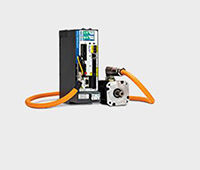Monitoring the level of liquid can be accomplished through the use of a pressure transducer. The density of the liquid and its height create pressure on the diaphragm of the transducer to generate an accurate level measurement. Generally, pressure transducers can be used for level measurement from 10 inches of water column, up to 10,000 PSI (700 bar).
Designed with stainless steel and Hytrel materials, submersible pressure transducers are reliable instruments to measure level for various liquids including water and diesel. These pressure sensors suit mobile applications such as ships, train cars or when the tank is transported between locations such as for construction sites, chemical totes for industrial processing, or well site injection chemicals.

A number of factors should be considered when installing a submersible pressure transducer in a tank. The outline drawing at the left shows one installation method used by American Sensor Technologies for its AST4510 submersible transducer using a rigid pipe. The AST 4510 comes standard with a ½ in. NPT male conduit connection at the base of the cable connection. In tanks that are turbulent due to an inlet/fill pipe or the use of an agitator, the transducer can have rigid plastic or metal conduit installed over the cable to prevent sensor movement within the tank.
The conduit over the cable is mounted to a bung at the top of the tank. Popular options are McMaster Carr Part #6805K28 that threads onto a 1.5 in. female NPT bung and has a ½ in. female NPT thread to mate the ridid conduit. (Other bung sizes are available for different applications). The cable, then, exits the tank and is held in place by a cord grip that runs to the control box. The same cable grip can be used at the junction box, ensuring that the vent tube is clear. Depending on hazardous location requirements, this can be in the non-hazardous area with connection to the intrinsically safe barrier. In this example, it is expected that the junction box is properly vented to the atmosphere to prevent water ingress.
In this application, the pressure sensor was installed above the base of the bottom of the tank. As sludge and silt tend to line the bottom of the tank, a height of 100 millimeters was calculated to ensure the process connection does not clog over time. The diaphragm of the transducer is close to the top of the process connection hex, so operates can calculate the offset from when the tank is empty.
Other applications may have the submersible pressure transducer installed directly into an intrinsically safe radio device at the top of the tank. This reduces the cost of the transducer as less cable and less time are required for the installation. With shorter cable lengths, you can have a voltage output signal with low current consumption, if the system is battery operated. Less current consumption means longer battery life and less maintenance.
American Sensor Technologies
www.astsensors.com
Filed Under: Sensors (pressure), MOTION CONTROL, SENSORS





Tell Us What You Think!